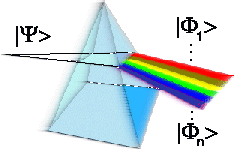Mariusz Gajda, Magdalena A Zaluska-Kotur and Jan Mostowski
We study an exactly solvable system of trapped bosonic particles interacting by model harmonic forces. The model allows for a detailed examination of the order parameter (condensate wavefunction) as well as a concept of the off-diagonal and diagonal order. We analyse the effect of interactions on the condensate and show that sufficiently strong interactions (attractive or repulsive) lead to the destruction of the condensate. In the thermodynamic limit this destruction has a critical character. It is shown that the existence of the coherent state of bosons is related to the existence of two length scales determined by one- and two-particle reduced density matrices. The condensate can exist only if the two length scales are of the same order. Interactions, both repulsive and attractive, change their relative size which may lead to destruction of coherence in the system and depletion of the condensate. We suggest that this scenario is model independent.
J. Phys. B 33, 4003 (2000)
Apr 13, 2000
Symmetries and modes of wave fields in inhomogeneous media
J. Phys. A 33, 4779 (2000)
Maciej Janowicz
In this paper the 2D Helmholtz equation with space-dependent dielectric permittivity and/or magnetic permeability is considered. The structure of the determining equations for the symmetry generator is analysed. It allows one to find many nontrivial spatial profiles of dielectric functions for which one can still separate variables in both the Helmholtz equation and corresponding Hamilton-Jacobi equation. For the case of the Dirichlet problem of the half-plane in an inhomogeneous medium the diffractive modes of the field are characterized. Several specific examples are provided.
Maciej Janowicz
In this paper the 2D Helmholtz equation with space-dependent dielectric permittivity and/or magnetic permeability is considered. The structure of the determining equations for the symmetry generator is analysed. It allows one to find many nontrivial spatial profiles of dielectric functions for which one can still separate variables in both the Helmholtz equation and corresponding Hamilton-Jacobi equation. For the case of the Dirichlet problem of the half-plane in an inhomogeneous medium the diffractive modes of the field are characterized. Several specific examples are provided.
Apr 5, 2000
Novel quantum effects in light scattering from cold trapped atoms
A. Orlowski, M. Gajda, P. Krekora, R. J. Glauber and J. Mostowski
Both far off-resonance and resonant scattering of light from single atoms trapped by 3D harmonic potentials has thoroughly been studied. Novel effects are predicted for different physical regimes. We have shown that dynamics of the atomic center-of-mass strongly influences the scattering cross section. Possibility of using spectrum of the scattered light in far-off-resonance regime to nondestructively measure the temperature of ultracold atoms is advocated: off-resonance scattering can be used as an ‘optical thermometer’. The realistic Compton-like regime in resonant scattering has been investigated in detail. Another interesting quantum effect in resonant regime, which has not been discussed here due to the lack of space, is the time resolved scattering, showing up when the atom can remain in the excited state long enough to make many trips back and forth in the trap before emitting a photon. The possibility of the experimental observation of the predicted effects is now being scrutinized.
Quantum Communication, Computing, and Measurement 2
Both far off-resonance and resonant scattering of light from single atoms trapped by 3D harmonic potentials has thoroughly been studied. Novel effects are predicted for different physical regimes. We have shown that dynamics of the atomic center-of-mass strongly influences the scattering cross section. Possibility of using spectrum of the scattered light in far-off-resonance regime to nondestructively measure the temperature of ultracold atoms is advocated: off-resonance scattering can be used as an ‘optical thermometer’. The realistic Compton-like regime in resonant scattering has been investigated in detail. Another interesting quantum effect in resonant regime, which has not been discussed here due to the lack of space, is the time resolved scattering, showing up when the atom can remain in the excited state long enough to make many trips back and forth in the trap before emitting a photon. The possibility of the experimental observation of the predicted effects is now being scrutinized.
Quantum Communication, Computing, and Measurement 2
Subscribe to:
Comments (Atom)
